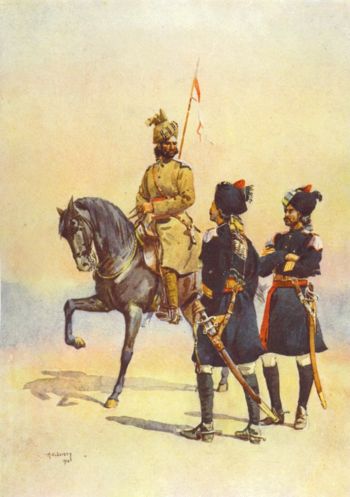36th Jacob's Horse
Contents
Chronology
- 1846 raised by Lieut John Jacob as 2nd Regiment of Scinde Irregular Horse
- 1860 became the 2nd Regiment of Scinde Horse
- 1861 became the 9th Regiment of Scinde Silladar Cavalry
- 1861 became the 2nd Regiment of Scinde Horse
- 1885 became the 6th Bombay Cavalry (Jacob-Ka-Rissallah)
- 1888 became the 6th Bombay Cavalry (Jacob’s Horse)
- 1903 became the 36th Jacob's Horse
- 1922 amalgamated with the 35th Scinde Horse to become the 14th Prince of Wales's Own Scinde Horse
- 1947 allocated to India on Partition
- 1950 became 14 Scinde Horse
Biographies
Entries in the Dictionary of Indian Biography 1906
John Jacob (1812-1858)
See also
Regimental History
Prince of Wales’s Own, The Scinde Horse 1839-1922 by Colonel E. B. Maunsell, first published 1926. Also available in a reprint edition,[1] which in turn is available online on fold3, a pay website, refer below.
First World War
The 36th Jacob's Horse went to France in 1914 with the Indian Corps and fought dismounted at Festubert (January 1915), at Ypres, and on the Somme (1916). Its greatest battle was Cambrai (1917) when it repeatedly counter-attacked the advancing enemy. In 1918, the 36th moved to Palestine. It fought in Allenby's great final cavalry operations (the actions at Sharan Megiddo, Abu Naj, and the advance to Damascus). The Turks defeated, the Regiment was kept in Syria as a garrison force until 1921 and then returned to India for the amalgamation.[1]
External Links
- 36th Jacob's Horse Wikipedia
- John Jacob Wikipedia
- 14th Prince of Wales's Own Scinde Horse Wikipedia
- Watercolour by Charles James Lyall 1903. Brown Digital Repository, Brown University Library. 1849. Sinde Irregular Horse Jacob's Horse. Officer
- Image: Kurta made for Jemadar Sadda Singh, The Scinde Horse (14th Prince of Wales's Own Cavalry), 1937 (c) nam.ac.uk. Retrieved 26 September 2014
Historical books online
- 2nd Regiment of Scinde Horse was raised in 1846 Allen’s Indian Mail 1846, page 203
- Scinde Irregular Horse Record Book www.archive.org
- Record book of the Scinde irregular horse Volume II 8th October 1851 to 13th June 1855 1856 Google Books
- Obituary of John Jacob, commander of the Scinde Horse, died 1858 Google Books
- General John Jacob Commandant of the Sind Irregular Horse and Founder of Jacobabad by Alexander Innes Shand 1901 Archive.org
- Prince of Wales's Own, the Scinde Horse 1839-1922 by Colonel E. B. Maunsell 1926 is available in a reprint edition,[1] which in turn is available online on the Ancestry owned pay website fold3 (located in World War II/Military Books/Britain).
References
- ↑ 1.0 1.1 1.2 Prince Of Wales’s Own, The Scinde Horse by Colonel E. B. Maunsell 1926 Naval & Military Press reprint edition.
